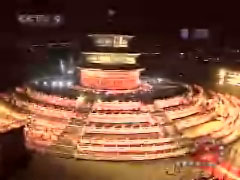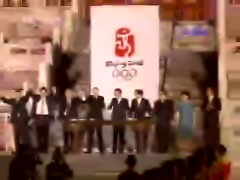 With the memory of the moment when they won the bid to host the 2008 Olympics still fresh in mind, the Chinese people couldn’t wait to see the logo of the 29th Olympic games. It’s a golden opportunity to show China’s will to embrace the family of nations and to demonstrate Chinese imagination and talent. Given the experience of previous Games, a universally accepted emblem is seen as an auspicious beginning of the long countdown to an outstanding Olympic games. With the memory of the moment when they won the bid to host the 2008 Olympics still fresh in mind, the Chinese people couldn’t wait to see the logo of the 29th Olympic games. It’s a golden opportunity to show China’s will to embrace the family of nations and to demonstrate Chinese imagination and talent. Given the experience of previous Games, a universally accepted emblem is seen as an auspicious beginning of the long countdown to an outstanding Olympic games.
It’s August 3, 2003 in the Chinese capital, Beijing. The curtain of night falls as the prelude of mass jubilation. A little more than two years after the metropolis won the bid for the 29th Olympic games; the emblem of the Games will be publicized on this special night. Starting a brief but highly symbolic tour from the famous Millennium Monument to the ancient Temple of Heaven, the much-anticipated logo will come under the spotlight in a lavish ceremony directed by the famous Chinese film director Zhang Yimou. Its unveiling will bring new glory to the Olympic family with a history, whose history can be traced to more than a century ago.
The mysterious emblem, which has attracted great expectations, finally reached the Temple of Heaven at about 8 pm. This is a site once used to pray for good harvest by ancient Chinese emperors and listed by UNESCO in 1998 as one of the World’s Cultural Heritage sites.
Liu Qi, President of BOCOC, said, “I can just tell you that it’s an excellent emblem, which bears a strong flavor of China.”
“The handling of the figure seems comparatively unrestrained. And it’s in close conformity with the spirit of sport,” said a Chinese judge.
Zhang Yimou, Director of Emblem Publication Film of Beijing 2008 Olympic games, said, “You can feel the combination of both the Olympic spirit and China’s ancient civilization with its long history.”
The number in the audience at the launching ceremony was set at 2008. Among them were leaders from the central government, International Olympic Committee officials and diplomats as well as many celebrities. In spite of his absence from the grand ceremony, IOC president Jacques Rogge delivered a video address.
Under the watchful eyes of the 2008 guests present and millions of TV viewers around the world, the moment has finally come for the unveiling of the Olympic logo.
Mr. Wu Bangguo, chairman of the NPC Standing Committee, and Hein Verbruggen, chairman of the IOC Coordination Commission for the 2008 Beijing Olympic Games unveiled the emblem.
Behind every symbol, there is a story. This is the story of a country opening a gate to the future, the story of a city stretching its arms to embrace all humanity, the story of a people inviting the world to join their experience, their culture and to share their joy. This is Dancing Beijing, the emblem of the 2008 Beijing Olympic Games. The upper part of the logo is a Chinese seal with only one Chinese character Jing in the shape of a dancing human. It also resembles a man opening his arms to welcome visitors. Jing is short for Beijing and literally means the “capital” which is the host city. By using the Chinese seal, long a symbol of personal credibility, the designers want to show the world that it is the sincere commitment of the Chinese people to host the best games ever. The color red is lavishly used in the logo because red means good luck and happiness in Chinese culture. From weddings to the national flag, the color red permeates almost every aspect of Chinese life. In a sense it is the national color. The middle part is the name of the host city and the year 2008. The letters are written in the style of Chinese calligraphy. And the bottom part is the five ring Olympic symbol.
 An audience has excitedly told to our reporter, “The emblem is very beautiful. At the moment of sealing the logo, the blood in my heart was boiling. It’s hard to describe my feeling in words. I’d just like to stand up stretching my arms and crying out “yeah”. It’s truly outstanding.”
An audience has excitedly told to our reporter, “The emblem is very beautiful. At the moment of sealing the logo, the blood in my heart was boiling. It’s hard to describe my feeling in words. I’d just like to stand up stretching my arms and crying out “yeah”. It’s truly outstanding.”
Another audience said, “I think that the emblem has strong Chinese elements. As you know, it includes the Chinese word of “jing” of “Beijing” and the color red has a special Chinese flavor. So I consider it a combination of the Chinese tradition and the world sport. It’s very meaningful.”
The logo not only appeals to the average Chinese, it also appeals to people internationally. When the logo was first presented to the IOC, the IOC officials all gave it high praise, saying the logo is the best ever designed.
To celebrate the unveiling of the emblem, a large-scale show was presented to the two thousand and eight in the audience in the brilliantly lit Temple of Heaven. The flaming suits of the corps of dancers matched flawlessly the red logo of Dancing Beijing, symbolizing the passionate hearts of all Chinese people.
A perfect combination of Chinese tradition and Olympic spirit has been put on the small logo of 2008 Beijing Olympic Games. Though there are still five years to go, it seems that a joyful Beijing already has the 2008 Olympic games in sight. Just like the name of the emblem, Beijing is dancing toward a best ever Games that will show both the traditional wisdom and modern spirit of an emerging China.
|